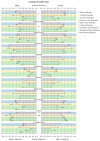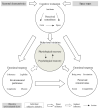How Does the Experience of Forest Recreation Spaces in Different Seasons Affect the Physical and Mental Recovery of Users?
- PMID: 36767723
- PMCID: PMC9915722
- DOI: 10.3390/ijerph20032357
How Does the Experience of Forest Recreation Spaces in Different Seasons Affect the Physical and Mental Recovery of Users?
Abstract
Background: In recent years, increasing attention has been given to the recovery effect of the forest environment on physical and mental health. Therefore, providing users with a high-quality forest landscape space is a very important research topic for forest landscape designers and forest resource managers.
Main purpose: From the perspective of different seasons, this study explores the differences in landscape perceptions and physical and mental recovery of users when they experience different forest recreation spaces and the interactions between them.
Methods: First, this study used virtual reality video experience and questionnaires for participants. Then, the paired-samples t test, one-way ANOVA and the independent-samples t test were used for statistical analysis. Finally, we also used structural equation models to analyze the relationship between landscape perception and recovery.
Main results: (1) The restoration effect and perception of forest recreation spaces on people are influenced by space types and seasonal factors. (2) People's restoration from forest environments is a gradual process from spatial cognition to emotional response. (3) The perception of the natural attributes and form of the recreation space plays a key role in the restorative effect of the environment to people, while the natural form is more important in spring than autumn. Based on the above conclusions, we suggest that the characteristic factors of the landscape environment and their different restoration effects for users in different dimensions should be considered when planning forest recreation space.
Keywords: environmental health; forest therapy; landscape perception evaluation; physical and mental recovery; seasonal characteristics.
Conflict of interest statement
The authors declare no conflict of interest.
Figures











Similar articles
-
Research on cognitive evaluation of forest color based on visual behavior experiments and landscape preference.PLoS One. 2022 Nov 3;17(11):e0276677. doi: 10.1371/journal.pone.0276677. eCollection 2022. PLoS One. 2022. PMID: 36327307 Free PMC article.
-
How Do Repeated Viewings in Forest Landscapes Influence Young People's Visual Behaviors and Cognitive Evaluations?Int J Environ Res Public Health. 2023 Mar 8;20(6):4753. doi: 10.3390/ijerph20064753. Int J Environ Res Public Health. 2023. PMID: 36981662 Free PMC article.
-
Effect of Forest Users' Stress on Perceived Restorativeness, Forest Recreation Motivation, and Mental Well-Being during COVID-19 Pandemic.Int J Environ Res Public Health. 2022 May 30;19(11):6675. doi: 10.3390/ijerph19116675. Int J Environ Res Public Health. 2022. PMID: 35682260 Free PMC article.
-
What do we expect from forests? The European view of public demands.J Environ Manage. 2018 Mar 1;209:139-151. doi: 10.1016/j.jenvman.2017.12.032. Epub 2018 Jan 4. J Environ Manage. 2018. PMID: 29289842 Review.
-
Health Benefits Derived from Forest: A Review.Int J Environ Res Public Health. 2020 Aug 23;17(17):6125. doi: 10.3390/ijerph17176125. Int J Environ Res Public Health. 2020. PMID: 32842490 Free PMC article. Review.
Cited by
-
Measuring restoration quality in urban forest greenways: insights for planning and management.Front Psychol. 2025 Jul 18;16:1596154. doi: 10.3389/fpsyg.2025.1596154. eCollection 2025. Front Psychol. 2025. PMID: 40755536 Free PMC article.
-
How the natural environment affects psychological recovery: A case study in Changsha, China.PLoS One. 2025 Jun 17;20(6):e0325755. doi: 10.1371/journal.pone.0325755. eCollection 2025. PLoS One. 2025. PMID: 40526756 Free PMC article.
References
-
- Fisher J.C., Irvine K.N., Bicknell J.E., Hayes W.M., Fernandes D., Mistry J., Davies Z.G. Perceived Biodiversity, Sound, Naturalness and Safety Enhance the Restorative Quality and Wellbeing Benefits of Green and Blue Space in a Neotropical City. Sci. Total Environ. 2021;755:143095. doi: 10.1016/j.scitotenv.2020.143095. - DOI - PubMed
-
- China National Forestry and Grassland Administration Government Website. [(accessed on 10 March 2022)];2022 Available online: http://www.forestry.gov.cn/main/56/20220129/085633644209695.html.
-
- Samus A., Freeman C., van Heezik Y., Krumme K., Dickinson K.J.M. How Do Urban Green Spaces Increase Well-Being? The Role of Perceived Wildness and Nature Connectedness. J. Environ. Psychol. 2022;82:101850. doi: 10.1016/j.jenvp.2022.101850. - DOI
-
- Alberti M. Advances in Urban Ecology: Integrating Humans and Ecological Processes in Urban Ecosystems. In: Alberti M., editor. Advances in Urban Ecology. 1st ed. Springer US Press; New York, NY, USA: 2009.
Publication types
MeSH terms
LinkOut - more resources
Full Text Sources

